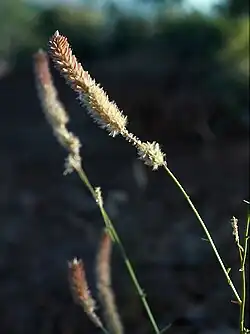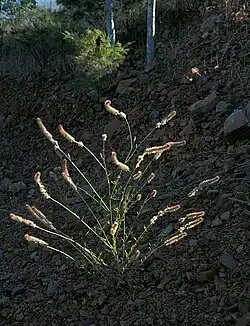Ptilotus giganteus
| Ptilotus giganteus | |
|---|---|

| |
| Scientific classification | |
| Kingdom: | Plantae |
| Clade: | Tracheophytes |
| Clade: | Angiosperms |
| Clade: | Eudicots |
| Order: | Caryophyllales |
| Family: | Amaranthaceae |
| Genus: | Ptilotus |
| Species: | P. giganteus
|
| Binomial name | |
| Ptilotus giganteus | |
| Synonyms[1] | |
|
List
| |

Ptilotus giganteus is a species of flowering plant in the family Amaranthaceae and is endemic to the north-west of Australia. It is an erect annual herb, with lance-shaped leaves with the narrower end towards the base, and cylindrical green spikes of flowers.
Description
Ptilotus giganteus is an erect annual herb, that typically grows to a height of up to 1 m (3 ft 3 in), its stems ribbed with a sparse covering of simple hairs. The leaves on the stems are arranged alternately, lance-shaped with the narrower end towards the base, 10–80 mm (0.39–3.15 in) long and 3–12 mm (0.12–0.47 in) wide. The flowers are arranged in cylindrical spikes 20–180 mm (0.79–7.09 in) long and 20–27 mm (0.79–1.06 in) wide, with narrowly egg-shaped, translucent bracts 2.0–3.8 mm (0.079–0.150 in) long, and broadly egg-shaped, straw-coloured bracteoles 2.8–4.4 mm (0.11–0.17 in) long and glabrous. The tepals are mostly 8–11 mm (0.31–0.43 in) long and there are 4 stamens and a single staminode, the style is 4.5–10.5 mm (0.18–0.41 in) long and straight, fixed to the centre of the ovary. Flowering occurs from March to September.[2][3][4]
Taxonomy
This species was first formally described in 1849 by Alfred Moquin-Tandon who gave it the name Trichinium giganteum in de Candolle's Prodromus Systematis Naturalis Regni Vegetabilis from an unpublished description by Allan Cunningham.[5][6] In 2010, Robert Wayne Davis and Ryonen Butcher transferred the species to Ptilotus as P. giganteus in the journal Nuytsia. The specific epithet (giganteus) means 'exceptionally large'.[7]
Distribution and habitat
Ptilotus giganteus grows on sandstone hills and plateaux in the Central Kimberley, Dampierland, Northern Kimberley, Ord Victoria Plain and Victoria Bonaparte bioregions of northern Western Australia[4] and the Gulf Fall and Uplands, MacDonnell Ranges, Ord Victoria Plain, Pine Creek, Sturt Plateau and Victoria Bonaparte bioregions of the Northern Territory.[3]
See also
References
- ^ a b "Ptilotus giganteus". Australian Plant Census. Retrieved 19 July 2025.
- ^ Davis, Robert Wayne; Butcher, Ryonen (2010). "Re-evaluation of Ptilotus polystachyus sens. lat. (Amaranthaceae) and creation of the new combination Ptilotus giganteus". Nuytsia. 20: 226–227. Retrieved 20 July 2025.
- ^ a b "Ptilotus giganteus". Northern Territory Government. Retrieved 19 July 2025.
- ^ a b "Ptilotus giganteus". FloraBase. Western Australian Government Department of Biodiversity, Conservation and Attractions.
- ^ "Trichinium giganteum". Australian Plant Name Index. Retrieved 19 July 2025.
- ^ Moquin-Tandon, Alfred (1849). de Candolle, Augustin (ed.). Prodromus systematis naturalis regni vegetabilis, sive, Enumeratio contracta ordinum generum specierumque plantarum huc usque cognitarium, juxta methodi naturalis, normas digesta. Paris: Sumptibus Sociorum Treuttel et Würtz. p. 296. Retrieved 20 July 2025.
- ^ George, Alex S.; Sharr, Francis A. (2023). Western Australian Plant Names and Their Meanings - A Glossary (fifth ed.). Kardinya: Four Gables Press. p. 210. ISBN 9780645629538.